from pocket-size to the world’s largest reference
Dictionaries can be something of a personal matter. People become very attached to their favourite amongst the most-used of all reference books. However, a few guidelines on how to choose a dictionary can easily be established. The first thing to understand is that they are not all the same. They have their own characters and peculiarities, and they are created for different users.
 Let’s start with the question of size. The smallest dictionaries, which you really can fit into your pocket, are only suitable for a quick check of spelling and meaning in most commonly used words. These are mini-books the size of cigarette packets, which often end up in your desk drawer. The Oxford English Minidictionary manages to pack 40,000 entries and 50,000 definitions into a miraculously small space – and throws in a few extra pages which offer solutions to common problems. Keep this in your briefcase, or take it along to the pub quiz, but for serious work you’ll need something bigger.
Let’s start with the question of size. The smallest dictionaries, which you really can fit into your pocket, are only suitable for a quick check of spelling and meaning in most commonly used words. These are mini-books the size of cigarette packets, which often end up in your desk drawer. The Oxford English Minidictionary manages to pack 40,000 entries and 50,000 definitions into a miraculously small space – and throws in a few extra pages which offer solutions to common problems. Keep this in your briefcase, or take it along to the pub quiz, but for serious work you’ll need something bigger.
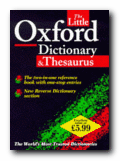 The Little Oxford Dictionary is the next size up. This is a more serious attempt to be useful, with 51,000 entries and supplementary information on each word, including how it should be pronounced. It also includes occasional panels of advice on grammar and good usage, plus a supplement of words which have come into the language during the 1990s. This is one for the desktop or your briefcase, and probably the smallest you can go if you are going to consult a dictionary regularly.
The Little Oxford Dictionary is the next size up. This is a more serious attempt to be useful, with 51,000 entries and supplementary information on each word, including how it should be pronounced. It also includes occasional panels of advice on grammar and good usage, plus a supplement of words which have come into the language during the 1990s. This is one for the desktop or your briefcase, and probably the smallest you can go if you are going to consult a dictionary regularly.
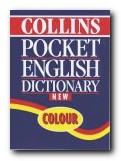 Collins offer an alternative to the Oxford domination of the dictionary market. Their books are popular because they generally make clear page layout a priority. The Collins Pocket Dictionary contains 44,500 definitions, plus advice on grammar and common problems. It claims to be ‘in colour’ – but all this turns out to mean is that headwords and their variants are printed in red – which makes the pages look as if they’ve got measles.
Collins offer an alternative to the Oxford domination of the dictionary market. Their books are popular because they generally make clear page layout a priority. The Collins Pocket Dictionary contains 44,500 definitions, plus advice on grammar and common problems. It claims to be ‘in colour’ – but all this turns out to mean is that headwords and their variants are printed in red – which makes the pages look as if they’ve got measles.
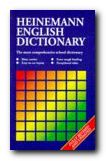 Amongst the ‘portables’, the Heinemann English Dictionary is specially designed for use in schools. Not only is each entry very clearly presented, but parts of speech are spelt out in full, not abbreviated as is usual in dictionaries. Pronunciation is explained, and there are pull-out boxes with gems of etymology on certain words. It has been created with the UK National Curriculum in mind – and has proved to be popular as a reference for the classroom.
Amongst the ‘portables’, the Heinemann English Dictionary is specially designed for use in schools. Not only is each entry very clearly presented, but parts of speech are spelt out in full, not abbreviated as is usual in dictionaries. Pronunciation is explained, and there are pull-out boxes with gems of etymology on certain words. It has been created with the UK National Curriculum in mind – and has proved to be popular as a reference for the classroom.
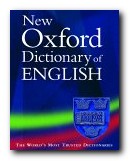 The New Oxford Dictionary focuses on English as it is really used in the late 20th century. Compiled after in-depth analysis of computerized databases of current English, this dictionary is the first to base its coverage on the evidence of real English. A rapid-reference page design separates out parts of speech, word histories, and phrases. The most modern meaning of each word, as used by the majority of people, is placed first within each entry. Contemporary rules are given on question of usage, providing relevant advice on problems old and new. Word history notes explain the linguistic roots of words and tell the story of how a word’s meaning and form have changed over time. Modern pronunciations are also given, using the internationally recognized system.
The New Oxford Dictionary focuses on English as it is really used in the late 20th century. Compiled after in-depth analysis of computerized databases of current English, this dictionary is the first to base its coverage on the evidence of real English. A rapid-reference page design separates out parts of speech, word histories, and phrases. The most modern meaning of each word, as used by the majority of people, is placed first within each entry. Contemporary rules are given on question of usage, providing relevant advice on problems old and new. Word history notes explain the linguistic roots of words and tell the story of how a word’s meaning and form have changed over time. Modern pronunciations are also given, using the internationally recognized system.
If you are buying a dictionary for serious use, paperbacks can be a false economy. Very often, hardback editions only cost slightly more – and they will last you a lifetime. Treat yourself!
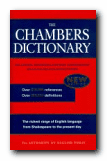 It’s official! The word techie – a devotee of technology – has made it into the Chambers Dictionary. And there are a slew of other net-specific words too, including netiquette, browsing, applet, spam, cybersex and cybercafé. It just goes to show how the world of computing and electronic communications has advanced and changed our world. Of course, there are also those other little things that have become part of our lives: Prozac, sound bite, cellulite…
It’s official! The word techie – a devotee of technology – has made it into the Chambers Dictionary. And there are a slew of other net-specific words too, including netiquette, browsing, applet, spam, cybersex and cybercafé. It just goes to show how the world of computing and electronic communications has advanced and changed our world. Of course, there are also those other little things that have become part of our lives: Prozac, sound bite, cellulite…
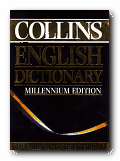 Collins dictionaries have always scored well on contemporary relevance and accessibility. The latest ‘Millennium’ edition of the Collins English Dictionary has increased the previous content by twenty percent, and there are useful guiding headers at the top of the pages, and the headword entries are printed in a no-nonsense non-serif font which I find unexpectedly easy to read. Besides answering the questions usual to dictionaries there are many encyclopedic entries which make this a valuable work of general reference. It also carries notes on language use which might be studied by those who think they speak English correctly.
Collins dictionaries have always scored well on contemporary relevance and accessibility. The latest ‘Millennium’ edition of the Collins English Dictionary has increased the previous content by twenty percent, and there are useful guiding headers at the top of the pages, and the headword entries are printed in a no-nonsense non-serif font which I find unexpectedly easy to read. Besides answering the questions usual to dictionaries there are many encyclopedic entries which make this a valuable work of general reference. It also carries notes on language use which might be studied by those who think they speak English correctly.
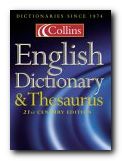 Collins also have on offer a ‘two-books-in-one’ Dictionary and Thesaurus. This carries 71,000 entries, plus a quarter of a million synonyms. Normal dictionary entries appear in the top half of each page, whilst the bottom half presents lists of synonyms and antonyms. This is a simple but very effective device which encourages browsing and learning about language. A useful choice if you need to combine two sources of reference in one.
Collins also have on offer a ‘two-books-in-one’ Dictionary and Thesaurus. This carries 71,000 entries, plus a quarter of a million synonyms. Normal dictionary entries appear in the top half of each page, whilst the bottom half presents lists of synonyms and antonyms. This is a simple but very effective device which encourages browsing and learning about language. A useful choice if you need to combine two sources of reference in one.
 The most popular of the one-volume desktop dictionaries is the Concise Oxford Dictionary. This contains explanations, pronunciation, and the etymology of over 40,000 headwords. It also adds notes on any disputed or controversial terms, and includes American spellings. This is a great favourite with writers and students, and a basic minimum for a civilized library. If you can only afford one dictionary – make it this one.
The most popular of the one-volume desktop dictionaries is the Concise Oxford Dictionary. This contains explanations, pronunciation, and the etymology of over 40,000 headwords. It also adds notes on any disputed or controversial terms, and includes American spellings. This is a great favourite with writers and students, and a basic minimum for a civilized library. If you can only afford one dictionary – make it this one.
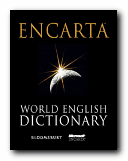 If you want an illustrated dictionary, Encarta has recently been released as one volume – to some acclaim. It represents both the diversity of English as a language spoken around the world, and an attempt to capture up-to-date usage. If you want a picture of an aardvark and details of zygotes – Encarta has them. It offers variant spellings, meanings, and pronunciations in more than 100,000 entries comprising some 3.5 million words. If, for example, your Asian correspondent asks you for your biodata, you can quickly and painlessly learn that she needs your curriculum vitae. There are more than 3,000 black-and-white illustrations and 10,000 biographical and geographical entries. This is Microsoft making good use of its linguistic database.
If you want an illustrated dictionary, Encarta has recently been released as one volume – to some acclaim. It represents both the diversity of English as a language spoken around the world, and an attempt to capture up-to-date usage. If you want a picture of an aardvark and details of zygotes – Encarta has them. It offers variant spellings, meanings, and pronunciations in more than 100,000 entries comprising some 3.5 million words. If, for example, your Asian correspondent asks you for your biodata, you can quickly and painlessly learn that she needs your curriculum vitae. There are more than 3,000 black-and-white illustrations and 10,000 biographical and geographical entries. This is Microsoft making good use of its linguistic database.
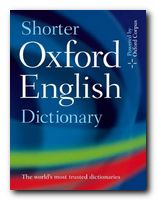 Moving towards the heavier, more serious resources for writers, students, and teachers who want the sort of books in their homes which are normally only available in libraries, the New Shorter Oxford is a firm favourite. It’s big, comprehensive, and scholarly, and is based on the monumental Oxford English Dictionary. All entries have been re-written to reflect contemporary usage. This is one which should be considered as a minimum for serious writers and researchers. It comes in two handsomely-produced volumes, which are a sound investment. Its also just been re-issued in a Oxford’s new easy-to-read format.
Moving towards the heavier, more serious resources for writers, students, and teachers who want the sort of books in their homes which are normally only available in libraries, the New Shorter Oxford is a firm favourite. It’s big, comprehensive, and scholarly, and is based on the monumental Oxford English Dictionary. All entries have been re-written to reflect contemporary usage. This is one which should be considered as a minimum for serious writers and researchers. It comes in two handsomely-produced volumes, which are a sound investment. Its also just been re-issued in a Oxford’s new easy-to-read format.
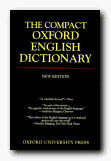 The Compact OED [an accurate but amazingly misleading title] is just about as far as you would need to go without being a library acquisitions officer or a professional lexicographer. It’s a two-volume version of the complete OED – but photo-reduced, so that the text is laid out in a font size of about six points. The volumes are issued as a cased set with a magnifying glass – and you’ll need it. But here’s the good news. It works. So you save on storage space, yet have access to the contents of the twenty volume version. I picked one up second hand, and use it all the time.
The Compact OED [an accurate but amazingly misleading title] is just about as far as you would need to go without being a library acquisitions officer or a professional lexicographer. It’s a two-volume version of the complete OED – but photo-reduced, so that the text is laid out in a font size of about six points. The volumes are issued as a cased set with a magnifying glass – and you’ll need it. But here’s the good news. It works. So you save on storage space, yet have access to the contents of the twenty volume version. I picked one up second hand, and use it all the time.
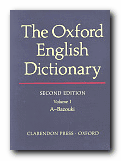 Of course when we get to the biggest and best dictionary of the English Language, and a towering monument of bibliographic scholarship – then it’s the complete Oxford English Dictionary. This is now twenty printed volumes and had become rather expensive to produce. There are the two options available. You can have the convenience, speed, and reliability of the whole database on a single disk. Keep it in your D: drive and the world’s biggest lexical resource can be summoned with a mouse-click. The alternative is to subscribe to the online version, which will be permanently updated. It’s worth noting that the OED editors have decided to adopt an all-inclusive policy. New English, slang, jargon, and even obscenities are all listed.
Of course when we get to the biggest and best dictionary of the English Language, and a towering monument of bibliographic scholarship – then it’s the complete Oxford English Dictionary. This is now twenty printed volumes and had become rather expensive to produce. There are the two options available. You can have the convenience, speed, and reliability of the whole database on a single disk. Keep it in your D: drive and the world’s biggest lexical resource can be summoned with a mouse-click. The alternative is to subscribe to the online version, which will be permanently updated. It’s worth noting that the OED editors have decided to adopt an all-inclusive policy. New English, slang, jargon, and even obscenities are all listed.
© Roy Johnson 2009
More on dictionaries
More on language
More on literary studies
More on writing skills